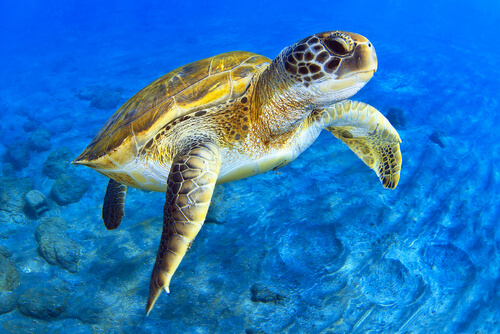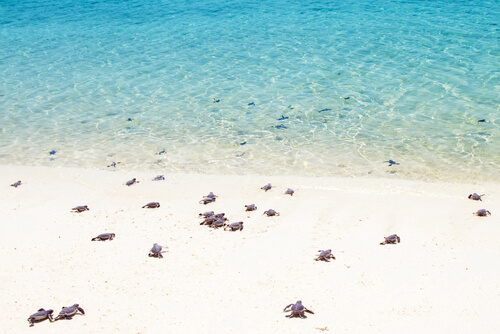
| Kingdom | Animalia |
| Phylum | Chordata |
| Class | Reptilia |
| Order | Testudines |
| Family | Cheloniidae |
| Genus | Chelonia |
| Species | C. mydas |
| Niche | Nomadic marine turtle |
| Length | 5 ft (1.5 m) |
| Weight | 695 lb (315 kg) |
| Lifespan | 60-70 years |
| Social Structure | Solitary |
| Conservation Status | Vulnerable |
| Preferred Habitat | Subtropical and tropical oceans |
| Average Clutch Size | 100+ |
| Main Prey Species | Seagrass, algae, crabs, jellyfish, sponges |
| Predators | Humans, sharks, foxes, cats, dogs, fish |
The Basics
The green sea turtle or is a large reptile of the family Cheloniidae. It inhabits marine ecosystems and lays its eggs on land in dramatic nesting events. The green sea turtle can weigh up to 695 lb (315 kg).

Description
The green sea turtle is one of eight extant sea turtle species and appears like a typical sea turtle. They can grow up to 5 feet long and weigh almost 700 pounds. On average, they grow to about 420 pounds with an average carapace length of about 3 feet. Their carapace changes color throughout their lives, beginning as nearly black in hatchlings and eventually becoming almost entirely brown with spotted or marbled patterning. It has long fore flippers and shorter hind flippers. They have a short beak and a short neck.
The green turtle’s carapace is composed of 13 sections – 5 central scutes surrounded by 4 pairs of lateral scutes. Mature turtles have a single claw on their front flippers which aid in manipulating food items.
Although the green sea turtle is closely related to the hawksbill turtle, it has several unique characteristics that set them apart. First, the green sea turtle’s beak is shaped differently, with less of a hooked bill than that present in the hawksbill sea turtle. Also, the green sea turtle is incapable of one of the most notorious traits of turtles: the ability to pull their heads into their shells for defense.
Distribution and Habitat
Green sea turtles live in most of the world’s oceans at subtropical to tropical latitudes. There are two major subpopulations in the Atlantic and the eastern Pacific oceans, each being genetically distinct. Each subpopulation also has its own nesting and feeding grounds within its range. In fact, the species can be observed in the coastlines of more than 140 countries and nest in more than 80 countries around the world each year. The largest and most dense populations of green sea turtles exist on Australia’s Great Barrier Reef as well as the Caribbean Sea.

Green sea turtles are a migratory species, generally migrating between feeding grounds to nesting sites on the beaches of coastlines within their range. They will also spend much of their time in the open ocean, often while traveling between these two types of sites.
Diet and Predators
Unlike many other sea turtles, the green sea turtle feeds largely on seagrass and algae. They will also eat other prey items such as jellyfish, crustaceans, and marine sponges.
Adult sea turtles face very little threat from predators apart from large shark species such as the great white shark or the tiger shark. However, eggs are fed on by many reptiles and mammals, including humans. Hatchlings are also very vulnerable and are often preyed upon before they make it to the sea, or by marine predators in the ocean. Indeed, very few hatchlings make it to adulthood. Of those that do, they generally live long lives, living up to 70 years of age.
Reproduction
Green turtles travel great distances between their breeding grounds and feeding grounds. After mating at sea, females will haul themselves up on the beach to lay their eggs. Under the cover of nightfall, they will dig a hole in the sand and lay about eighty eggs before covering them again and returning to the sea.

New hatchlings are highly susceptible to predation and very few of the eggs laid by each female will survive to adulthood. Female hatchlings will roam the oceans until they reach sexual maturity at around 10 to 15 years of age. At this point, they will return to the same nesting area they were born to breed again and restart the cycle anew. Males, in contrast, spend the rest of their lives at sea, living mostly solitary for the rest of their lives.
Conservation Status
Humans are a significant threat to green sea turtles. In many areas where they nest, eggs are taken from nests for consumption or as false aphrodisiacs. Once grown, many turtles are killed by fishing lines and nets, often incidentally as bycatch. Plastic pollution and habitat destruction are further threats to the species.
In the Atlantic ocean, the population of leatherback sea turtles appears to be stable following a decline from 1980s levels. However, the Pacific population is declining rapidly and have disappeared altogether in some areas such as Malaysia. These populations are Critically Endangered while the species as a whole is listed as “Vulnerable” by the IUCN Red List of Threatened Species.
Fun Facts about the Green Sea Turtle!
The green sea turtle is one of the largest shelled turtles in the world and a relatively famous and popular species, making them excellent symbols of marine conservation as well as a fascinating species through which to explore various biological concepts.
Eating Green
Although the carapace of mature green sea turtles is actually brown or olive-colored, much of their cartilage and fat is green, hence their common name. Fascinatingly, this is a result of their somewhat unique diet among sea turtles.
Unlike other sea turtles, much of the green sea turtles’ diet consists of seagrass and algae. This is thought to contribute to the unique coloring of their tissues, a trait that is not observed in other sea turtle species that are primarily carnivorous. It is not uncommon in the animal kingdom for colors to be derived from diets, confirming that in many cases you are indeed what you eat.

A New Home
Females sea turtles are known to return to their natal beaches – the beaches on which they were hatched – to lay their own eggs. Mature females will normally return to these beaches every 2-4 years between June and September. However, there are some exceptions to this.
Although rare, in some cases, a female may not be able to find her way to her natal beach. This may be due to changes in ocean currents or perhaps the destruction of that beach and nesting site by human developments or pollution. In such cases, females will still seek to lay their eggs. However, they don’t simply select any other beach. Instead, studies have shown that females will select beaches with as similar characteristics as possible, including sand of the same size and composition.
Subpopulations
Fascinatingly, the Atlantic and eastern Pacific subpopulations are genetically distinct. One of the primary genetic differences between the two subpopulations is the type of mitochondrial DNA found in an individual’s cells. Turles from the Atlantic subpopulation and the Mediterranean Sea have a similar type of mitochondrial DNA to each other. Meanwhile, individuals from the Pacific and Indian Oceans have another type of mitochondrial DNA, distinguishing them from the Atlantic populations.
This distinction in mitochondrial DNA (mDNA) is likely a result of the populations being isolated from each other by the southern tips of both South America and Africa, beyond which the waters are too cold for the populations to migrate through, restricting their ability to interbreed. Geographical isolation is a strong speciation force in nature and this distinction in mDNA between these two subpopulations may be considered an early sign of the subpopulations becoming two distinct species (or subspecies) of the sea turtle.
